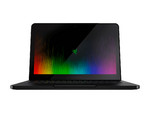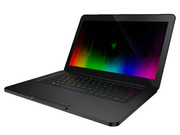Razer Blade FHD Matte, Kaby Lake
Ausstattung / Datenblatt

Preisvergleich
Durchschnitt von 9 Bewertungen (aus 12 Tests)
Testberichte für das Razer Blade FHD Matte, Kaby Lake
Quelle: Techradar
 EN→DE Archive.org version
EN→DE Archive.org versionThe 2017 Razer Blade is stronger and longer lasting than last year’s, making that steep price tag all that much easier to justify. But, as the Blade begins to out-pro the MacBook Pro much less comparable gaming laptops, we'd like to see more original features come to this model.
Einzeltest, online verfügbar, Lang, Datum: 08.05.2018
Bewertung: Gesamt: 90%
Quelle: Techno Buffalo
 EN→DE Archive.org version
EN→DE Archive.org versionThere are other alternative computers that offer the same specs as the Blade, but none offer the same premium and portable design. And that’s why you should consider Razer’s beefy laptop: To receive a level of refinement few others can match.
Einzeltest, online verfügbar, Mittel, Datum: 03.09.2017
Bewertung: Gesamt: 80%
Quelle: Reviewed.com
 EN→DE Archive.org version
EN→DE Archive.org versionIf you like to game on-the-go, you can't get much better than the Blade. Between the slim profile and top-tier components, it not only packs serious computing power, it's also one of the most portable gaming laptops I've ever seen. Whether you're tweaking that presentation at the airport or watching Stranger Things on your morning commute, it's the type of laptop that works well as a productivity machine too.
Einzeltest, online verfügbar, Kurz, Datum: 02.09.2017
Bewertung: Gesamt: 90%
Quelle: Techspot
 EN→DE Archive.org version
EN→DE Archive.org versionThe main factor that will prevent people from buying the Razer Blade is its price. The Blade starts at $1,900 for the model with 256GB of storage, but really you’ll want to spend at least $2,100 to net yourself a 512GB SSD. This makes the Blade several hundred dollars more expensive than any equivalent GTX 1060 gaming laptop, even slim competitors from MSI and Gigabyte. If you want the best, you’ll need to pay for the best.
Einzeltest, online verfügbar, Sehr Lang, Datum: 22.05.2017
Bewertung: Gesamt: 85%
Quelle: Hardware Zone
 EN→DE Archive.org version
EN→DE Archive.org versionThe only other point of contention is how much of a gaming experience can you appreciate from a 14-inch screen as opposed to the more common 15.6-inch gaming notebook models, for which there are plenty of choices. This clearly boils down to personal needs like high portability, yet wanting to have great gaming hardware equivalent to the larger notebooks. If so, the Razer Blade is your clear choice. However, if you clearly prioritize the need for a larger screen for better visual impact, which is quite important for gaming casually or professionally, you should consider the 15.6-inch gaming notebook tier instead.
Einzeltest, online verfügbar, Sehr Lang, Datum: 15.05.2017
Bewertung: Gesamt: 85% Preis: 80% Leistung: 80% Mobilität: 90% Gehäuse: 90%
Quelle: Techradar
 EN→DE Archive.org version
EN→DE Archive.org versionThe 2017 Razer Blade is stronger and longer lasting than last year’s, making that steep price tag all that much easier to justify. But, as the Blade begins to out-pro the MacBook Pro much less comparable gaming laptops, we'd like to see more original features come to this model.
Einzeltest, online verfügbar, Sehr Lang, Datum: 04.04.2017
Bewertung: Gesamt: 90%
Quelle: The Verge
 EN→DE Archive.org version
EN→DE Archive.org versionBut at the end of the day, the Razer Blade is largely effortless machine. While it lacks the customization of a full-sized gaming desktop, Razer’s made great choices when it comes to the Blade’s hardware, leaving you with a powerful, actually portable gaming laptop that looks great and most importantly, plays games great. The Razer Blade may be based in compromises, but Razer seems to have found a niche that makes it just right.
Einzeltest, online verfügbar, Sehr Lang, Datum: 31.03.2017
Bewertung: Gesamt: 80%
Quelle: Hexus
 EN→DE Archive.org version
EN→DE Archive.org versionThe 2017 Blade is without a doubt Razer's best revision to date. Now armed with an Intel Core i7-7700HQ processor and Nvidia GeForce GTX 1060 graphics, this unmistakable 14in machine has the rare ability to double as an everyday workhorse and a potent full-HD gaming platform.
Einzeltest, online verfügbar, Sehr Lang, Datum: 20.03.2017
Quelle: Laptop Mag
 EN→DE Archive.org version
EN→DE Archive.org versionHowever, if you want all the colors of the rainbow and then some, you might want to consider the Alienware 13 and its incredible OLED display. Starting at $1,799, the Alienware 13 has similar specs and power, although it's somewhat heavier and has shorter battery life. But if you're looking for a VR-ready notebook that's powerful, portable and downright pretty, you can't go wrong with the Razer Blade.
Einzeltest, online verfügbar, Sehr Lang, Datum: 15.03.2017
Bewertung: Gesamt: 80%
Quelle: Trusted Reviews
 EN→DE Archive.org version
EN→DE Archive.org versionPeople on the market for an Ultrabook, or Windows-flavoured MacBook Pro rival, have plenty of options. For example, the Dell XPS 15 doesn’t match the Blade for graphical grunt, but it’s cheaper, lighter and, if you go for the GTX 1050 option, is more than good enough for video editing and lightweight gaming.
Einzeltest, online verfügbar, Sehr Lang, Datum: 14.02.2017
Bewertung: Gesamt: 80% Preis: 70% Leistung: 90% Bildschirm: 80% Mobilität: 60% Gehäuse: 80%
Quelle: CNet
 EN→DE Archive.org version
EN→DE Archive.org versionRazer made its slim 14-inch Blade into one of the smallest VR-ready PCs last September by dropping in Nvidia's GeForce GTX 1060 GPU. That's now being joined by the latest "Kaby Lake" silicon from Intel.
Einzeltest, online verfügbar, Kurz, Datum: 13.02.2017
Quelle: PC Online.com.cn
 zh-CN→DE Archive.org version
zh-CN→DE Archive.org versionPositive: Powerful hardware; high gaming performance; good cooling system; slim size.
Einzeltest, online verfügbar, Sehr Lang, Datum: 17.04.2017
Kommentar
NVIDIA GeForce GTX 1060 Mobile: High-End Notebook-Grafikkarte mit 6 GDDR5-Grafikspeicher und drittschnellste mobile Pascal-GPU nach der GTX 1080 und GTX 1070. Verfügt über 1.280 Shadereinheiten und taktet identisch wie die Desktop-Version.
Diese Klasse ist noch durchaus fähig neueste Spiele flüssig darzustellen, nur nicht mehr mit allen Details und in hohen Auflösungen. Besonders anspruchsvolle Spiele laufen nur in minimalen Detailstufen, wodurch die grafische Qualität oft deutlich leidet. Diese Klasse ist nur noch für Gelegenheitsspieler empfehlenswert. Der Stromverbrauch von modernen Grafikkarten in dieser Klasse ist dafür geringer und erlaubt auch bessere Akkulaufzeiten.
» Weitere Informationen gibt es in unserem Notebook-Grafikkartenvergleich und der Benchmarkliste.
i7-7700HQ: Auf der Kaby-Lake-Architektur basierender Quad-Core-Prozessor für Notebooks. Integriert neben den vier CPU-Kernen (inkl. Hyper-Threading) auch eine HD Graphics 630 Grafikeinheit und wird im verbesserten 14-Nanometer-Prozess gefertigt.» Weitere Infos gibt es in unserem Prozessorvergleich Vergleich mobiler Prozessoren und der Prozessoren Benchmarkliste .


